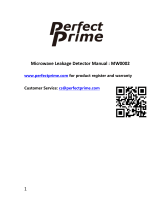
11
Martindale Electric is pleased to offer you this service. Please
contact our Service Department for details.
Tel: 01923 650660
4.3 Cleaning
If contamination is found, clean with a damp soft cloth and if
necessary a mild detergent or alcohol. Do not use abrasives,
abrasive solvents, or detergents which can cause damage to the
unit. If a mild detergent is used, the unit should subsequently
be thoroughly cleaned with a water dampened soft cloth. After
cleaning, dry and allow to remain in a dry environment for 2 hours
before use.
4.4 Repair & Service
There are no user serviceable parts in this unit other than those
that may be described in section 4. Return to Martindale Electric if
faulty. Our service department will quote promptly to repair any fault
that occurs outside the guarantee period.
Before the unit is returned, please ensure that you have checked
the unit and battery.
4.5 Storage Conditions
The instrument should be kept with the battery removed, in warm
dry conditions away from direct sources of heat or sunlight, and
in such a manner as to preserve the working life of the unit. It is
strongly advised that the unit is not kept in a tool box where other
tools may damage it.
12
5. WARRANTY AND LIMITATION OF LIABILITY
This Martindale product is warranted to be free from defects in
material and workmanship under normal use and service. The
warranty period is 2 years and begins on the date of receipt by the
end user. This warranty extends only to the original buyer or end-
user customer, and does not apply to fuses, disposable batteries,
test leads or to any product which, in Martindale’s opinion, has been
misused, altered, neglected, contaminated, or damaged by accident
or abnormal conditions of operation, handling or storage.
Martindale authorised resellers shall extend this warranty on new and
unused products to end-user customers only but have no authority to
extend a greater or different warranty on behalf of Martindale.
Martindale’s warranty obligation is limited, at Martindale’s option, to
refund of the purchase price, free of charge repair, or replacement
of a defective product which is returned to Martindale within the
warranty period.
This warranty is the buyer’s sole and exclusive remedy and is in lieu
of all other warranties, expressed or implied, including but not limited
to any implied warranty of merchantability or fitness for a particular
purpose. Martindale shall not be liable for any special, indirect,
incidental or consequential damages or losses, including loss of data,
arising from any cause or theory.
Since some jurisdictions do not allow limitation of the term of
an implied warranty, or exclusion or limitation of incidental or
consequential damages, the limitations and exclusions of this
warranty may not apply to every buyer. If any part of any provision
of this warranty is held invalid or unenforceable by a court or other
decision-maker of competent jurisdiction, such holding will not affect
the validity or enforceability of any other provision or other part of
that provision.
Nothing in this statement reduces your statutory rights.
Specification
TEK500 Microwave
Leakage Detector
ELECTRICAL
LED indication thresholds: 1, 5, 10 mW/cm
2
Threshold accuracy: ±1dB for plane wave of all
polarizations
Audible indication: >5mW/cm
2
Frequency of operation: 2450 ± 25MHz
Response to step input change: <1 second
Overload capacity: 50mW/cm
2
GENERAL
Power: 1 x 9V, PP3 alkaline battery (IEC 6LR61,
NEDA 1604A)
Dimensions: 145 x 64 x 30mm
Distance from flat of conical spacer to field sensor: 50mm
Weight: Approx. 164g including battery
Includes: TM2 thermometer, 275mL beaker, 1 litre beaker,
carry case, 1 x 9V battery, instructions
ENVIRONMENTAL
Operating conditions: Temperature: -5°C to 40°C
Relative humidity: 10 to 80% R.H.
Storage conditions: Temperature: -10°C to 50°C
Relative humidity: 0 to 80% R.H.
FUNCTIONALITY
Conforms to the routine testing requirements of BS EN 60335-2-25
and BS EN 60335-2-90 for a microwave leakage detector
18th Edition Testers
Accessories
Calibration Equipment
Continuity Testers
Electricians’ Kits
Environmental Products
Full Calibration & Repair Service
Fuse Finders
Digital Clamp Meters
Digital Multimeters
Labels
Microwave Leakage Detectors
Motor Maintenance Equipment
Multifunction Testers
Non-trip Loop Testers
Pat Testers & Accessories
Phase Rotation Testers
Proving Units
Socket Testers
Thermometers & Probes
Test Leads
Voltage Indicators
Specialist Metrohm Testers (4 & 5kV)
Specialist Drummond Testers
Check out what else you can get from Martindale:
Martindale Electric Company Limited
Metrohm House, ImperialPark, ImperialWay,
Watford, Hertfordshire, WD244PP, UK
Tel: +44(0)1923 441717 Fax: +44 (0)1923 446900
Website: www.martindale-electric.co.uk
© Martindale Electric Company Ltd. 2018 Registered in
England No. 3387451. Rev 6 LIT500





